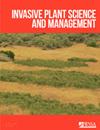载虫量和载虫率对水雷草和沙草抑菌效果的影响
IF 1.2
4区 生物学
Q3 PLANT SCIENCES
引用次数: 0
摘要
摘要/ Abstract摘要:2020年通过温室试验,研究了单次施用载体体积和乙氧基肟对水雷草(Panicum repens L.)防治和沙草(Spartina bakeri Merr.)反应的影响。在处理后14、28和42 d (DAT)的评价中,随着乙氧基肟用量的增加,白蚁的控制和生物量减少普遍增加;然而,将速率提高到最大标记速率的2倍并不总是导致疗效的提高。在由小型植物组成的第一次实验中,在测试的载体体积(37,187和935 L ha-1)中,白杨的控制和生物量减少基本相似。然而,在运行2中,由较大的成熟的重蓬草植株组成,随着载体体积的减少,效果增加。随着sethoxydim率的增加,米草草的伤害也在增加,在42个DAT时达到45%的最大值。然而,在14和28次DAT评估中,没有观察到不同载体体积的面包球菌伤害差异。bakeri的地上生物量减少主要是由于sethoxydim速率的增加而不是载体体积的减少,初始地上生物量减少了40% ~ 50%。与935 L ha-1处理相比,37或187 L ha-1处理的烤面包草地下生物量增加了20% ~ 32%。综上所述,这些数据表明,通过减少935 L ha-1的载体体积,乙醛氧基肟可以增强对白刺草的选择性控制,并且与根生白刺草相比,本地多年生枯生草可能对乙醛氧基肟表现出更强的耐受性。未来的研究应在实际规模的现场条件下进一步检验这些假设。本文章由计算机程序翻译,如有差异,请以英文原文为准。
Sethoxydim performance on torpedograss (Panicum repens) and sand cordgrass (Spartina bakeri) as affected by carrier volume and rate
Abstract Greenhouse experiments were conducted in 2020 to investigate the effects of carrier volume and sethoxydim rate on torpedograss (Panicum repens L.) control and sand cordgrass (Spartina bakeri Merr.) response from a single application. Panicum repens control and biomass reduction generally increased with increasing sethoxydim rates in evaluations at 14, 28, and 42 d after treatment (DAT); however, increasing the rate to 2X the maximum labeled rate did not always result in increased efficacy. In the first experimental run, which consisted of small plants, P. repens control and biomass reductions were largely similar among tested carrier volumes (37, 187, and 935 L ha–1). However, in run 2, which consisted of larger, mature P. repens plants, efficacy increased when carrier volume was reduced. Spartina bakeri injury increased with sethoxydim rate, reaching a maximum of 45% by 42 DAT. However, no differences in S. bakeri injury among carrier volumes were observed at 14 and 28 DAT evaluations. Spartina bakeri aboveground biomass reductions were also largely driven by sethoxydim rate increases rather than reduced carrier volumes, reaching 40% to 50% reduction in initial aboveground biomass. However, S. bakeri belowground biomass was 20% to 32% greater in treatments applied at 37 or 187 L ha–1 compared with those at 935 L ha–1. Overall, these data suggest that selective P. repens control with sethoxydim may be enhanced through reducing carrier volumes from 935 L ha–1 and that native, perennial, caespitose grasses may exhibit greater tolerance to sethoxydim compared with the rhizomatous P. repens. Future research should further test these hypotheses under field conditions at operational scales.
求助全文
通过发布文献求助,成功后即可免费获取论文全文。
去求助
来源期刊

Invasive Plant Science and Management
PLANT SCIENCES-
CiteScore
2.20
自引率
9.10%
发文量
24
审稿时长
6-12 weeks
期刊介绍:
Invasive Plant Science and Management (IPSM) is an online peer-reviewed journal focusing on fundamental and applied research on invasive plant biology, ecology, management, and restoration of invaded non-crop areas, and on other aspects relevant to invasive species, including educational activities and policy issues. Topics include the biology and ecology of invasive plants in rangeland, prairie, pasture, wildland, forestry, riparian, wetland, aquatic, recreational, rights-of-ways, and other non-crop (parks, preserves, natural areas) settings; genetics of invasive plants; social, ecological, and economic impacts of invasive plants and their management; design, efficacy, and integration of control tools; land restoration and rehabilitation; effects of management on soil, air, water, and wildlife; education, extension, and outreach methods and resources; technology and product reports; mapping and remote sensing, inventory and monitoring; technology transfer tools; case study reports; and regulatory issues.
 求助内容:
求助内容: 应助结果提醒方式:
应助结果提醒方式:


